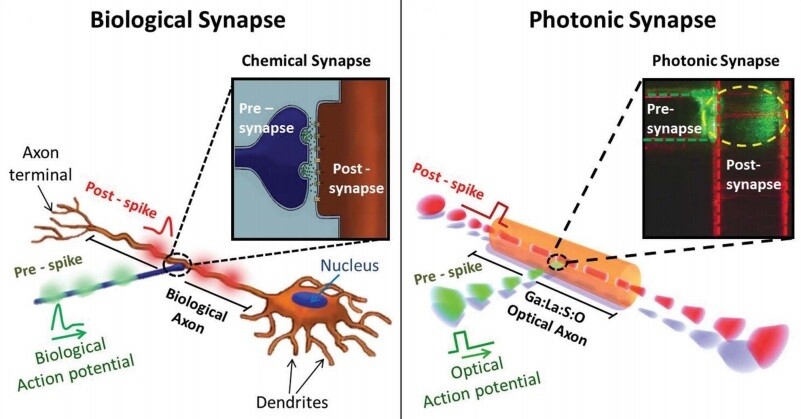Researchers at the University of Southampton and the Nanyang Technological University (NTU) in Singapore have found that fiber optics can be used to build low-power, high-bandwidth artificial neurons that mimic their biological counterparts. Used inside a properly designed chip, this technology could lead to computers that think and learn like a human.
The human brain can process huge amounts of information very quickly, and on a tiny power budget of just 20 W. Unfortunately, even the latest and greatest supercomputers are playing catch-up in both respects, as they suffer from architecture-driven bottlenecks that limit data processing speed and require on the order of a million times more power to run brain simulations in slow motion.
These limitations are intrinsic to the way today’s computers are built and so, if we want to build a machine that thinks and learns like a human, we might need to rethink the way such a machine would work. Neuromorphic computing, a new discipline that uses electronics to mimic the biology of the brain, could be the the answer.
By featuring a dense web of interconnections through which data can travel, and by consuming energy only when a signal is being fired, neuromorphic chips get past the issues of conventional computing and could just be the ideal architecture for building an artificial brain.
Previous neuromorphic systems relied on electronics alone, but now a team of researchers led by Prof. Cesare Soci at NTU has found that a sulfur-derived glass can be used to build neuromorphic chips based on fiber optics. Using this new technology could further boost data bandwidth and decrease power consumption of these devices to equal, and perhaps even surpass, the performance of biological neurons.

As in a true neuromorphic device, the artificial optical synapse looks and behaves like its biological counterpart. In fact, from a functional standpoint, the main difference is simply that while in a normal brain the signals that activate neurons are electrical in nature, here the signals are optical.
Because the inner workings of a neuromorphic chip are so similar to those of an actual brain, researchers believe that a detailed understanding of how the human brain works could be translated to an artificial brain with relative ease. One theory in neuroscience, for instance, states that the brain learns by association through the simple principle that "neurons that fire together wire together." If this is true, and if neuromorphic chips can be scaled up to a useful size, then implementing a high-performing, low-power computer capable of learning by itself might be within reach.
"This work implies that 'cognitive' photonic devices and networks can be effectively used to develop non-Boolean computing and decision-making paradigms that mimic brain functionalities and signal protocols, to overcome bandwidth and power bottlenecks of traditional data processing," said Soci.
The researchers claim that photonic artificial neurons could one day outperform their biological counterparts in transmission speeds, data bandwidth and power consumption, and also say that one way to build scaled-up, compact systems could be to replace the optical microfibers with silicon nanophotonic or plasmonic waveguides.
A paper describing the advance appears in the latest issue of the journal Advanced Optical Materials.
Source: University of Southampton





